What are Feathered Dinosaurs?
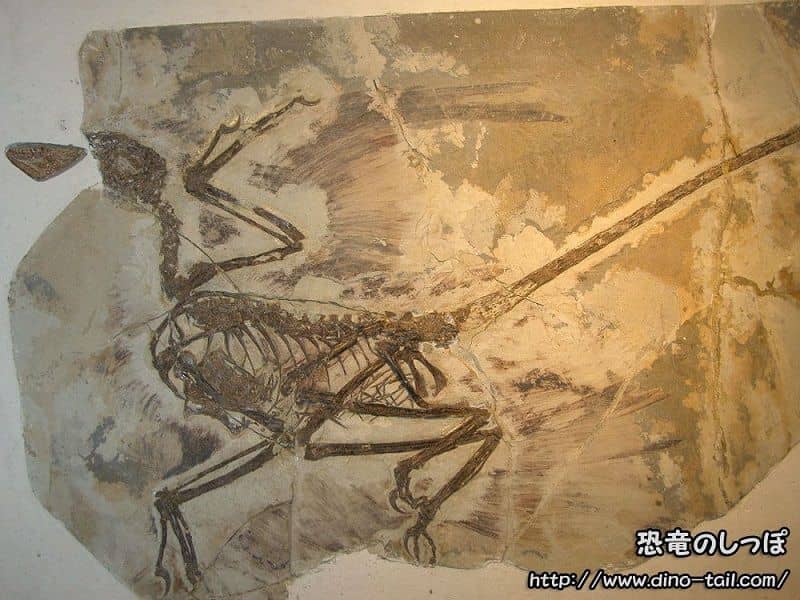
Traces of feathers are clearly visible on all four limbs.
Feathered dinosaurs are dinosaurs whose fossils have preserved traces of feathers. There is no academic classification of "feathered dinosaur"; it is used as a general term for "dinosaurs with traces of feathers."
Currently, traces of feathers have been found in over 20 genera of dinosaurs.
"Birds are dinosaurs."
This is now a widely accepted theory. While modern birds belong to the "Dinosauria" superorder in cladistics, we don't call pigeons and parrots "feathered dinosaurs." This is because most people generally imagine the group that excludes birds when they think of "dinosaurs."
In academic texts, to be precise, the term "non-avian dinosaurs" is often used as a note or prefix. This site also features information about "non-avian dinosaurs."
The Role of Feathers
It is believed that feathers developed from specialized scales. The acquisition of feathers began with downy, cotton-like fuzz.
At first, they were not feathers for flight. They were not suitable for cutting through the air to fly.
Why did dinosaurs develop feathers? Research is currently underway to answer this question.
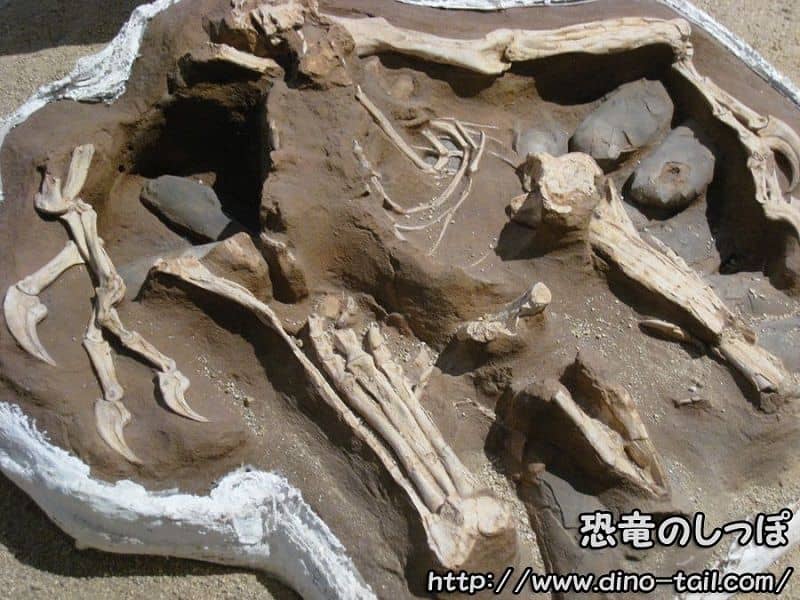
Its position in the center of the nest, with its arms spread to cover the eggs, is similar to modern birds.
It is thought that the initial purpose for dinosaurs acquiring feathers was for insulation. In particular, small dinosaurs, which are more susceptible to temperature changes, developed feathers. Maintaining a constant body temperature helps them to be active regardless of the season or time of day. This would have been a significant advantage over other cold-blooded animals. Fossils of oviraptorids have been found in a brooding position. It seems some had the habit of warming their eggs.
However, it is also known that the world had a warm climate throughout the Mesozoic Era when dinosaurs flourished. It is also thought that insulation alone could not have driven the development of feathers.
It is presumed that feathers had many other roles besides "insulation."
It was once said that "color cannot be determined from fossils." This is because during the fossilization process, the bones are replaced by minerals, so the color itself is not preserved.
However, in 2010, a paper from China stating that "the feathers of the theropod dinosaur Sinosauropteryx contained melanosomes, intracellular organelles containing melanin pigment, making color analysis possible" sent shockwaves through the paleontological community. It was revealed that Sinosauropteryx had reddish-orange feathers from its back to its tail. Subsequently, the body and feather colors of other dinosaurs like Anchiornis have also been analyzed.
As a result, it has become clear that the feathers of feathered dinosaurs had a wide variety of colors.
Like modern birds, it is suggested that dinosaur feathers may have played a role in attracting mates, identifying members of the same species, and for display or intimidation.
Whether it was to protect themselves from predators or to secure new food sources and prey is unknown, but small dinosaurs and theropods that expanded their habitat to the treetops appeared.
There must have been some dinosaurs that, by climbing trees with their sharp claws and jumping off, realized that their feathered limbs—"wings"—could generate lift (a gentle floating force). At first, they lacked the power to flap their wings and likely glided or descended slowly, storing air like a glider. From there, over a long period, they would follow the path to becoming birds.
The maniraptorans that chose to stay in the air for longer periods evolved their feathers into flight feathers. They changed into feathers suitable for catching the air.
They also fused their left and right clavicles to create a structure called the
- Body insulation = a function to support a high basal metabolic rate
- Brooding = fossils of oviraptorids have been found brooding their eggs
- Attracting mates = it is known that the tail of Sinosauropteryx had orange feathers. Like modern birds, it seems they used color for courtship and attracting mates.
- Intimidation = the glossy black feathers of Anchiornis are said to have had a visual intimidation function. Perhaps like a modern crow.
- Gliding from trees = the wings of Microraptor, although unable to flap up and down, were useful for gliding from trees
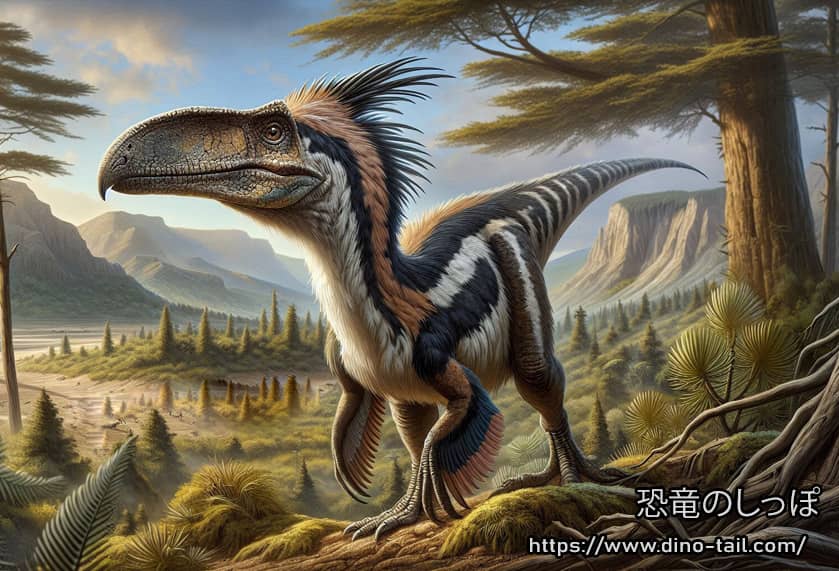
Powered by DALL-E3, 2024.
The Dinosaur Origin of Birds Theory
In 1870, the English biologist Thomas Huxley proposed the theory that "due to the many similarities in the skeletons of dinosaurs and birds, birds may have evolved from a group of dinosaurs (theropods)." This is the "dinosaur origin of birds theory."
However, if this were true, "feathered dinosaurs like birds should be found in the process of evolution," but no such fossils had been discovered at that time. Richard Owen, a leading authority on dinosaur research at the time, rejected Thomas Huxley's theory, stating that "birds and dinosaurs are systematically far apart," and the "dinosaur origin of birds theory" was not supported.
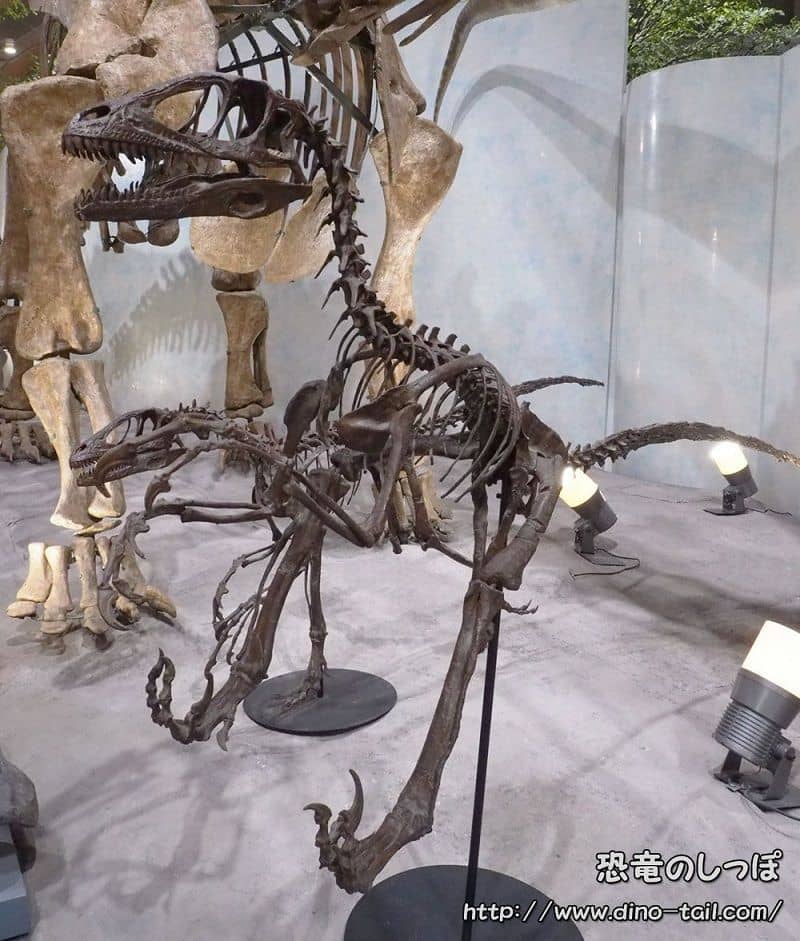
The "dinosaur origin of birds theory" came into the spotlight about 100 years later, triggered by a report in 1964 by the American paleontologist John Ostrom, who had studied the skeleton of the theropod Deinonychus.
As a result of his investigation of the Deinonychus skeleton, John Ostrom went on to advocate the warm-blooded dinosaur theory. This sparked what is known as the "Dinosaur Renaissance," a major shift in thinking about dinosaurs.
The discovery and research of the bird-like Deinonychus overturned the previously held image of "slow, sluggish dinosaurs" and supported the image of "agile, active dinosaurs." The relationship between active, warm-blooded dinosaurs and birds began to be debated.
However, to definitively establish the "dinosaur origin of birds theory," the discovery of a feathered dinosaur was necessary.
The Discovery of Feathered Dinosaurs
A paper published in 1996 stunned the world.
From a 124-million-year-old stratum in Liaoning Province, China, the first dinosaur fossil with traces of feathers was found.
It is believed that fine-grained volcanic ash falling on the remains prevented contact with air and rapid decay, resulting in the miraculous preservation of the fossil in excellent condition.
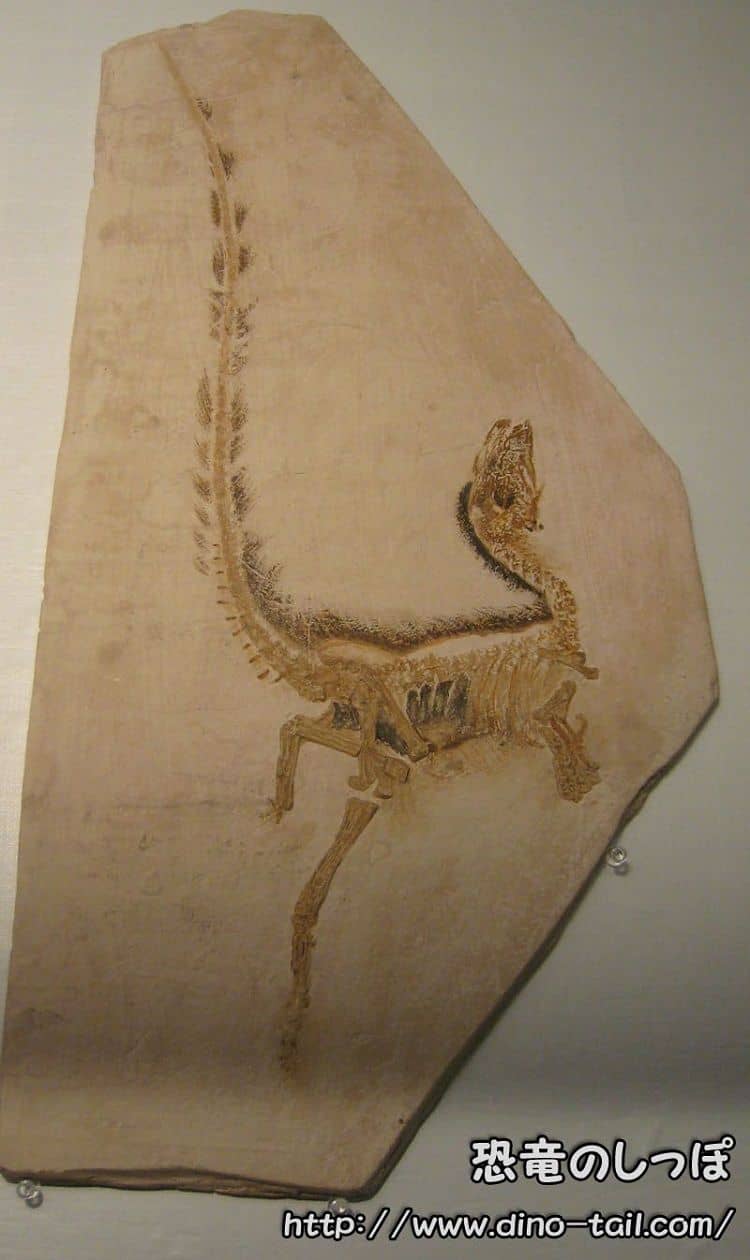
Traces of feathers are clearly preserved from the back to the tail.
The 1-meter-long dinosaur fossil, named Sinosauropteryx, clearly showed traces of downy feathers.
Subsequently, the view that these traces, which looked like feathers, were keratinous skin sparked controversy, but it is now understood that they were indeed feathers.
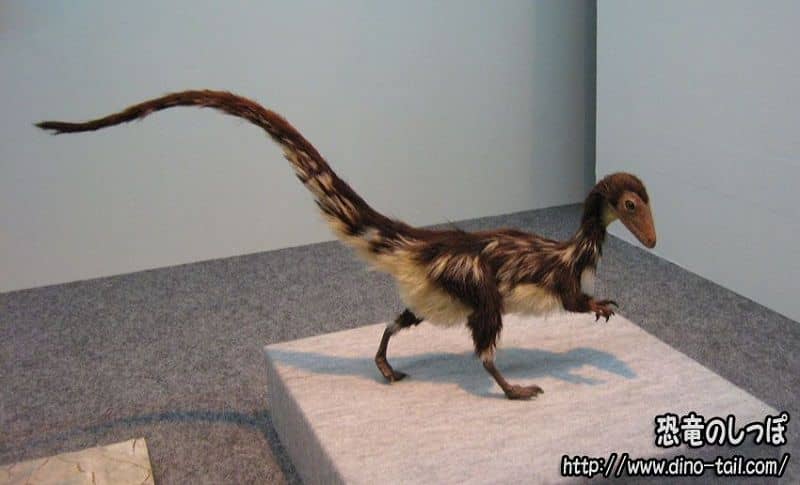
Since then, dinosaur fossils with feather traces have been discovered in many genera, including Caudipteryx, Dilong, and Microraptor.
Today, feathered dinosaurs have been found even in relatively large species, and similarities with birds are being reported one after another.
The theory that
"birds are descendants of dinosaurs - they evolved from the Saurischian theropod group"
has become an established fact.
Feathered Ornithischian Dinosaurs
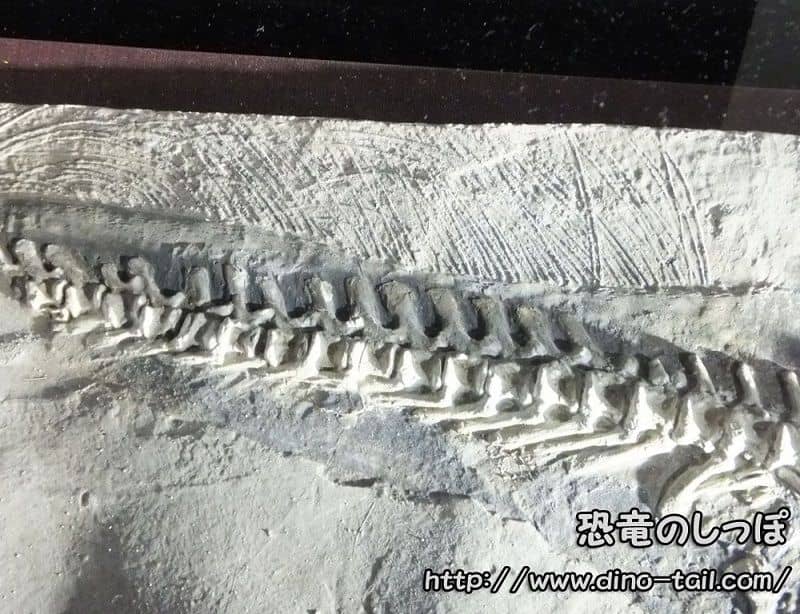
Traces of bristles are preserved.
Dinosaurs branched into [Saurischia] and [Ornithischia] at an early stage of their evolution.
Within [Saurischia], a lineage included in [Theropoda] would later evolve into birds.
In 2014, a discovery was made that suggested "dinosaurs may have had feathers from the very beginning of their evolution."
Traces of feathers were found in a dinosaur fossil from [Ornithischia], a different lineage from the one that led to birds.
In 2001, traces of bristles were found on the tail of Psittacosaurus (Ornithischia-Marginocephalia). These were different from avian feathers, being hollow, porcupine-quill-like tubular bristles (keratinous spines), but they were important evidence showing that not only theropods leading to birds, but also ornithischian dinosaurs had developed their own "feather-like structures," sparking a lively debate about the origin of feathers in all dinosaurs.
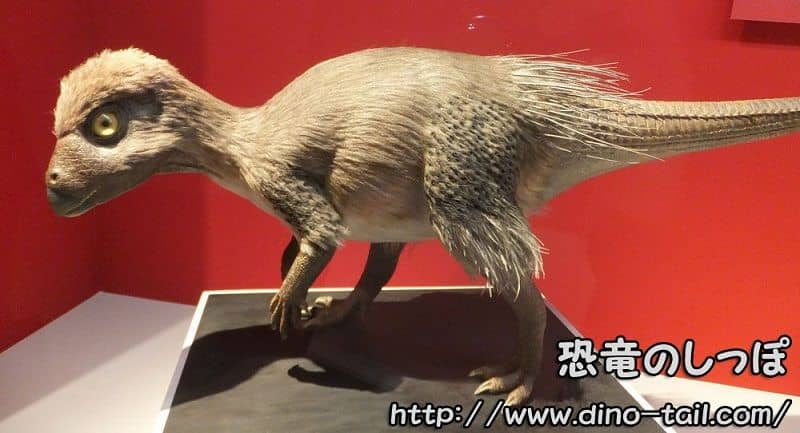
The discovery of the ornithischian ornithopod Kulindadromeus in 2014 led to new insights into the acquisition of feathers in dinosaurs. Despite being an ornithischian ornithopod, it was covered in feathers.
Kulindadromeus had different types of feather traces on different parts of its body, including short, bristle-like feathers and downy feathers.
If we assume that the acquisition of feather tissue occurred only once in the history of life, it would mean that dinosaurs had acquired feathers before they diverged into Saurischia and Ornithischia.
This discovery suggests the possibility that many species of dinosaurs had feathers for insulation.
